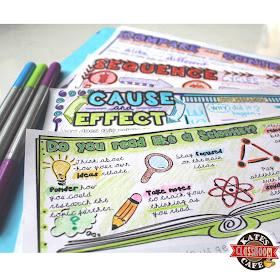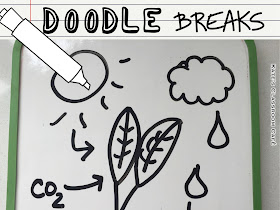 |
Engaging students with science models has long been at the cornerstone of quality science instruction, but could we be doing even more to improve visual literacy in our science classes?
Visual Learning
Visual
literacy is no doubt a 21st Century Skill that should be emphasized in every classroom. When students “interpret,
recognize, appreciate, and understand information presented through visible
actions, objects and symbols” there is bound to be improved learning in all content areas. So are we doing enough to teach this skill?
Science teachers know the importance of practice, imagery and patterns when helping our students grasp concepts. So it's no surprise that our daily instruction involves interactive notebook templates, card sorts, task cards, video clips and visual games that target these memory tools and work to keep students engaged along the way. But what about using another visual approach to make meaning and promote memory of science content?
Science teachers know the importance of practice, imagery and patterns when helping our students grasp concepts. So it's no surprise that our daily instruction involves interactive notebook templates, card sorts, task cards, video clips and visual games that target these memory tools and work to keep students engaged along the way. But what about using another visual approach to make meaning and promote memory of science content?
Many people rely heavily on visuals while learning new content. How many times have you skimmed an online article or textbook chapter reading only the headings and scanning the pictures, all along obtaining most of the content without ACTUALLY reading it? All the time! This
“less is more” study showed that pictures and short descriptions
proved more effective in reaching students than a full-text approach to
teaching science.
You are probably aware of the recent trend in coloring for improved memory, learning and even for stress relief. So it likely comes as no surprise that recent research is backing the idea that doodling can help our students better connect with the content we are teaching.
You are probably aware of the recent trend in coloring for improved memory, learning and even for stress relief. So it likely comes as no surprise that recent research is backing the idea that doodling can help our students better connect with the content we are teaching.
Consider
this study, where
a test group was asked to doodle while listening to a prerecorded message about a party. The experimental
group was asked to doodle while listening and were then tested on their ability to
recall the names mentioned. The “doodlers” recalled 29% more information than the control
group.
Sunni Brown, author of Doodle Revolution strives to redefine doodling as "spontaneous marks to help you think." Her TED Talk is well worth a watch and will really get you thinking about how our negative perceptions of doodling could be hindering student learning.
Ok, so most of what I've read about doodling supports academic doodling, mindless doodling and everything in between. Sorry doodle fanatics, but I'm not willing to open the doors of my classroom to a bunch of unstructured scribbling while I'm teaching.
Academic doodling, everyday doodling or a little of both? For my own sanity in managing a class of 27 teenage doodlers I think it makes sense to encourage the former. Doodling has long been associated with inattention, and let's face it- despite all the latest research, in a middle school classroom sometimes doodling is just that! So it got me to thinking...Can I teach my students HOW to doodle to support their learning?
I suggest talking with your students about doodling. Share the benefits and discuss how setting some goals and guidelines will ensure that it will be a productive learning tool. This chart might help with your discussion, OR your students might be able to come up with their own anchor chart to post in the classroom!
Ready to Get Started?
Here are some ways to get started with academic doodling:
Here are some ways to get started with academic doodling:
- Activate prior knowledge with a flash doodle.
- Incorporate doodling and coloring into traditional note-taking.
- Use whiteboard doodle breaks.
This strategy works great for reluctant doodlers! There is something about being able to erase a doodle that gets students more willing to take risks. Build in a DOODLE BREAK into any lesson! Simply ask all students to do a 60-second quick draw of a concept being taught. This is a non-threatening and valuable formative assessment!
- Use Printable Visual Notes. (AKA DOODLE NOTES, SKETCH NOTES)
These are becoming increasingly popular with teachers, and for good reason. Students interact with the content by doodling, shading, coloring and answering questions to improve understanding. A well-organized visual can have a lasting impression on a learner, and this style of note-taking does just that.
Printable doodle notes emphasize CONCISE and very VISUAL notes over a lengthy text. The material is grouped together in meaningful ways so as to improve student associations between concepts.
Example: This Earth's Spheres Doodle has a ton of information, but it is concisely organized to articulate the main ideas and details about how each sphere is connected with others.
The style, structure and graphics vary a lot for each concept. A great deal of time is spent adjusting text and graphics so that they are JUST RIGHT to teach a topic and so that each doodle note page is unique. Every page should be its own academic doodle work of art!
Whether you create your own or download premade doodle notes, here are some things to consider:
5 Fantastic things about DOODLE NOTES
Doodle Notes Provide MEMORY TRIGGERS
Bending the word "REFLECT" at a right angle at the letter L is an example of providing a "memory trigger" that can help students recall how light behaves. Clever placement of images and descriptions takes time, but it provides students with a memorable and topic-specific visual for improving understanding that can't be found on traditional graphic organizers.
This Layers of the Earth Doodle creates layers for organizing information, chunking essential science ideas together.
This food chain doodle uses a simple, yet carefully arranged chain of circles that shows how energy moves UP the food chain. This visual structure provides room for descriptions and examples to support understanding of this essential ecology concept. Using shapes that relate to concepts (like the sun, carbon dioxide and water) can also prove helpful when students are studying.
Doodle Notes sometimes provide room for STUDENT PRACTICE. (Q and A)
This Newton's Laws 1st Law Doodle is designed with a Q and A format. This format lends itself well to some topics better than others. Many students can remember the law of inertia, but they lack the practice needed to correctly apply the concept to everyday examples. This doodle reviews the law and then gives room to tackle some very visual questions!
Doodle Notes SORT and SEQUENCE information with intention. (Simple to complex, smallest to largest etc.)
For example, this Earth, Sun, Moon doodle doodle note lists the topics from left to right by size. Since many students struggle with the size and distance relationships in space, presenting them in this order may improve student recall.
Doodle Notes have MANY CLASSROOM APPLICATIONS. They can enhance your existing pre-teaching, initial instruction, practice or assessment. They also are a "print and go" differentiation and remediation tool.
Note: It is important to select (or create) a doodle note page that is good match for YOUR students and their needs. Be sure to look at previews and descriptions carefully when looking for pre-made versions. The best, most beautiful doodle notes page is only a valuable learning tool if it is selected for the right group of students at the right time!
Some example doodle notes pages:
This weathering doodle note summarizes the topic with lots of examples of both physical and chemical forms, so it makes a great test review sheet. The file includes a version with less info and more blank space so you can pick the one that best matches your students. (Some teachers are using the different versions for differentiated review.)
This Study SKILLS doodle note page is ideal for teaching students HOW to study a few days before a major science test! (It comes with some study skills stations too, so that kids can doodle and DO some studying to show they understand.)
This pH scale doodle is packed with information and makes a great introduction to acids and bases. Like many doodle notes files, there are a few versions (of the same page) to pick and choose from. Some with more blank space, others with more text and graphics already filled in.
Clipart and Font Credits to:
Can't find a pre-made doodle note sheet for a topic you teach? I take requests! Email me at scienceclassroomcafe@gmail.com for more information.

















